An Unforgettable Trip Of 2025 To Jai Vilas Mahal In Gwalior
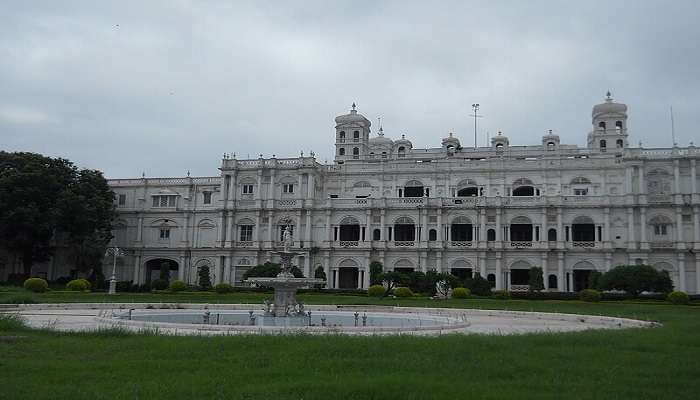
Jai Vilas Mahal, also known as Jai Vilas Palace in Gwalior, Madhya Pradesh, is the perfect blend of architectural styles and royal lifestyle. The grand palace was built in the 19th century and embodies the luxury and aestheticism of the Scindia dynasty. This magnificent palace, with around 400 rooms, is a masterpiece of architectural genius and royal indulgence. It is today the Scindia Museum, showcasing the opulent lifestyle and rich heritage of the Scindias. The Jai Vilas Mahal has become a place of interest among history buffs and those responsive to royal magnificence. It has become some sort of Gwalior’s best-known place to visit.
Jai Vilas Mahal History

Maharaja Jayajirao Scindia built Jai Vilas Mahal in 1874 as a symbol of his unmatched wealth and power. It was designed by an Italian architect, Sir Michael Filose, who created a unique structure applying European styles of architecture.
Improvements in the palace construction became one of the most famous events in Gwalior’s history, which displayed modernisation and the era of greatness under the Scindias. Over the years, it has housed several dignitaries and has been the venue for many royal ceremonies and feasts, and therefore is viewed more as a symbol of royal pride than any other tourist destination.
Also Read: Places To Visit In Gwalior
Exploring Architectural Marvel Of Jai Vilas Mahal
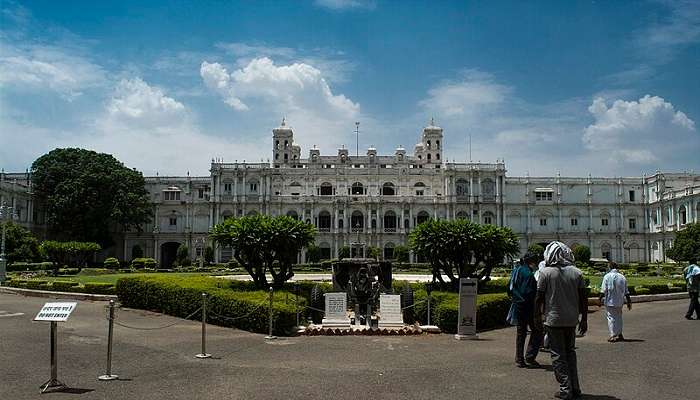
Jai Vilas Mahal represents a beautiful blending of various European styles with Italianate structures, Corinthian columns, and Tuscan arches. The frontage of the palace is full of intricate carvings and detailing, which more than adequately projected the prowess of artisans of the time. The Durbar Hall is one of the most remarkable features of the palace, with two enormous chandeliers and a ceiling plated with sybaritic gold. The hall is decorated with opulent furniture, rich tapestries, and luxuriant decoration, thus truly expressing the opulence and grandeur of the Scindia dynasty. Equally impressive are the landscaped gardens, fountains and courtyards that enhance the royal place.
Timing: 10 AM to 4:30 PM
Best time to Visit: April to September
The Grand Durbar Hall At Jai Vilas Mahal
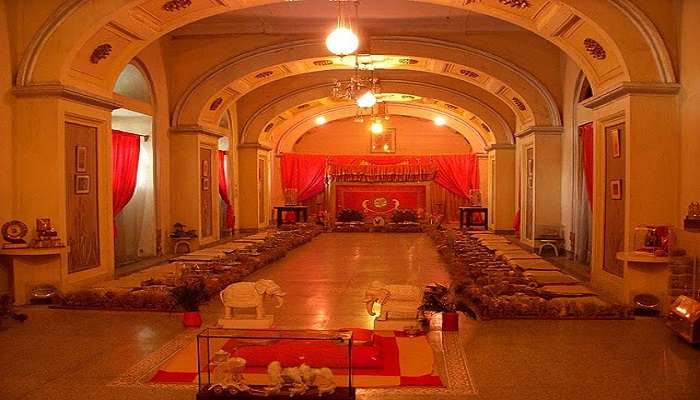
The Durbar Hall is the perfect example of royal luxury at Jai Vilas Mahal. It is one of the most famous pieces of architecture, housing two huge chandeliers weighing around 3.5 tons each—one of the biggest in the world. Eight elephants were hanging from the ceiling as a precaution to see that the chandeliers were strong enough to carry such enormous weight before the fitting of such chandeliers. Elaborate gold leaf work and other decorations highlight the hall’s ceiling and provide the most exquisite visual treat. Lavish furnishings and the grandeur of chandeliers make the Durbar Hall an important attraction of Jai Vilas Mahal.
Entry Fee: 150
Holidays: Wednesday
Related Post: Places To Visit Near Gwalior
Attractions In Scindia Museum
The Scindia Museum in the Jai Vilas Mahal gives an insider view of the princely heritage and lifestyle of Scindia family members. A large collection of articles belonging to the Scindia rulers, such as royal costumes, antique furniture, historical documents, and many more personal belongings, are displayed in this museum. An important collection includes a silver train with cut-glass wagons, which was especially used for serving drinks and refreshments at a royal banquet. It also houses an armoury, paintings, and sculptures that reflect the artistic and cultural heritage left behind by Scindias. Scindia Museum is a storehouse of history and culture. It gives an emphasis on the royal bequest for viewers.
1. The Lavish Interiors
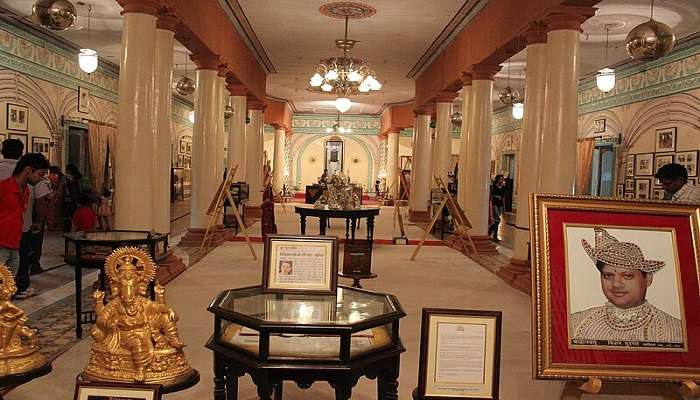
The interiors of Jai Vilas Mahal reflect the luxury and grace of the Scindias. They are so beautifully furnished and ornamented with lovely decorations and intricate works of art, uttering the royal lifestyle experienced in these times. The Durbar Hall remains a major attraction with gigantic chandeliers and ceilings gilded with gold.
The two lush dining halls give a prominent impression of full elegance with long tables and beautiful settings. Further, it also includes well-planned and attractively furnished bedrooms, lounges, and reception rooms, each reflecting a blend of European and Indian styles. In reality, it is the interior, which is equipped with all the luxuries in an ostentatious way that makes one feel about the royal way of living pursued by the Scindias in Jai Vilas Mahal.
Related Post: Things To Do In Gwalior
2. The Royal Library
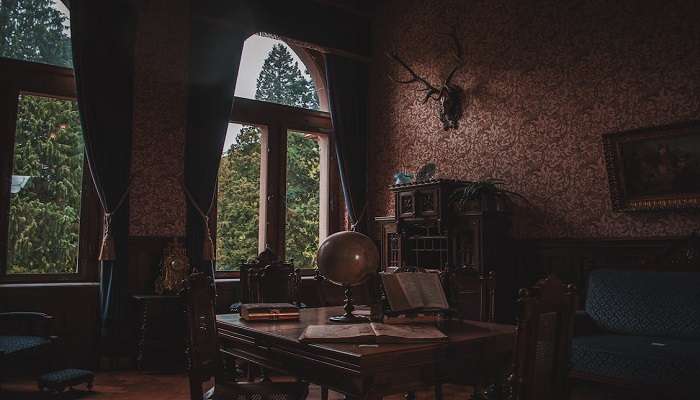
Now comes a place that history buffs are going to find really interesting. The Royal Library in the Jai Vilas Mahal actually houses a collection of a lot of knowledge and history in terms of a huge range of very rare books. It epitomises the scholastic endeavours and intellectual proclivities of the Scindia house of rulers.
The library is splendidly furnished with wooden shelving, well-furnished reading tables, and peace, making it an abode or heaven for book lovers and history enthusiasts. The collection consists of books on the subjects of literature, history, science, and philosophy. The Royal Library is the imaginative insight into their scholastic pursuits and the intellectual legacy of the Scindia house.
3. The Gardens And Courtyards Of Jai Vilas Mahal
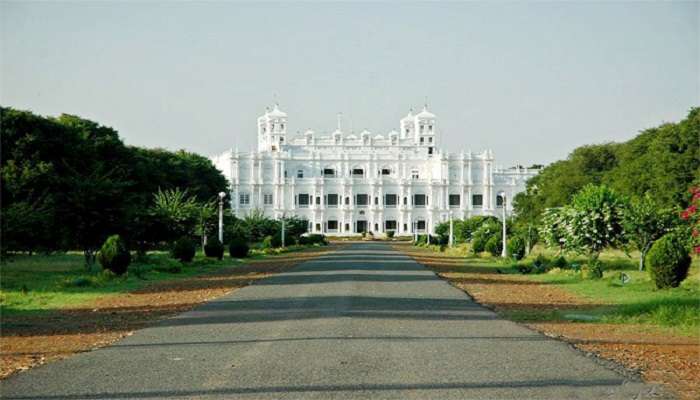
The charm of the palace, Jai Vilas Mahal, is further increased with the presence of gardens and courtyards in its vicinity, which impart tranquillity and picturesque appeal to the palace. The beautifully landscaped greens, flowers, and fountains adorn the palace’s beautiful gardens. The Palace epitomises architectural excellence and beauty, adorning courtyards full of intricate carvings and ornate decoration.
The gardens offer a calm and peaceful escape from the city’s life rush to every visiting heart, offering one the opportunity to sit and relax their minds with the beauty. The gardens, as well as courtyards, within the Jai Vilas Mahal, are living examples of the grandeur and magnificence of the palace.
Related Post: Places To Visit In Madhya Pradesh In June
4. The Silver Train
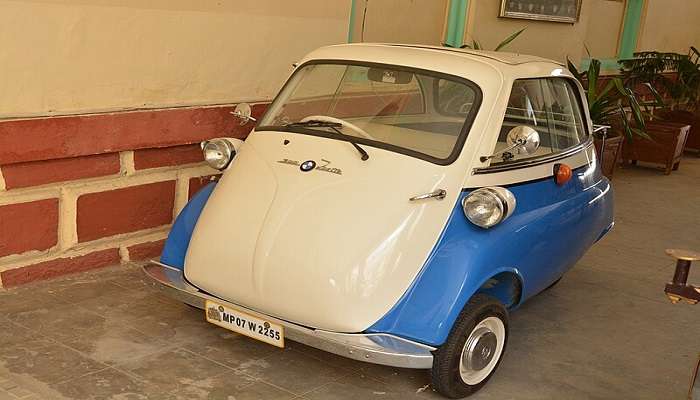
One such unusual and delightful feature of the Jai Vilas Mahal is a silver train fitted with cut-glass wagons, which chugged along the tracks around the massive, 2.4-tonne model dining table, stopping in front of each of the guests seated there to serve drinks and refreshments just as it would have done in royal banquets.
That was one of the specialties that identified the luxury and grandeur of opulence with which the Scindia dynasty lived. The highlight within the Scindia Museum, the silver train, signifies a bygone lifestyle of royalty in the minute detailing showcased in every iota of design and decoration of the palace.
5. The Scindia Legacy
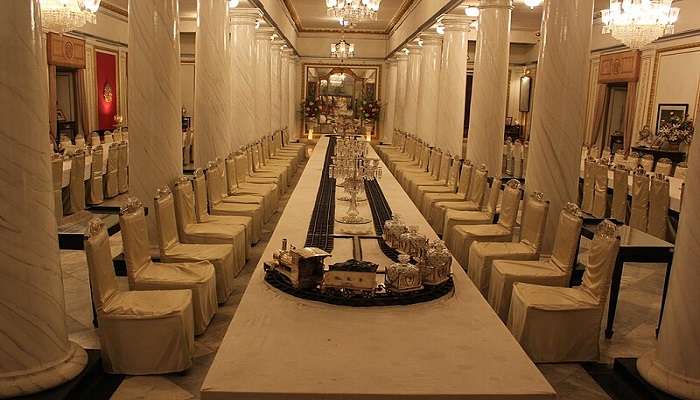
The Scindia dynasty has played the most provoking and significant role in the history and development of Gwalior. The legacy of the Scindias forms part of the culture and architectural heritage of the region. Under the responsible guidance of Maharaja Jayajirao Scindia, the development of Jai Vilas Mahal heralds an age of modernity and magnificence in Gwalior.
The Scindias, who patronised art, culture, and education, had given an impetus to the cause, stimulating growth and progress in this region. The Jai Vilas Mahal is the epitome of Scindian times and the contribution thereof toward the enrichment of Gwalior’s heritage.
Related Post: Shopping In Gwalior
6. Restoration And Preservation Of Jai Vilas Mahal
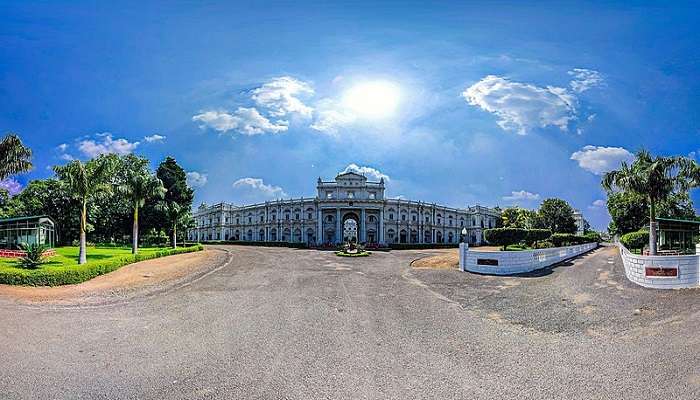
Over the years, innumerable efforts have made it possible to preserve and return the lost glory of the Jai Vilas Mahal. The palace has stood against time and remains one important site of culture and historical grandeur.
Many restoration works have been carried out by the Scindia family itself, along with the government and organisations working on heritage conservation, in order to keep the architectural integrity and historical importance of the palace intact. Such are the truly magnificent efforts that Jai Vilas Mahal’s legacy is carried into time for future generations to appreciate and view. The restoration and preservation of Jai Vilas Mahal is a testament to the commitment to saving rich cultural heritage in India.
Local Places Of Interest Around Jai Vilas Mahal
Here are the top places of interest that must be on your list while visiting the Mahal.
1. Gwalior Fort
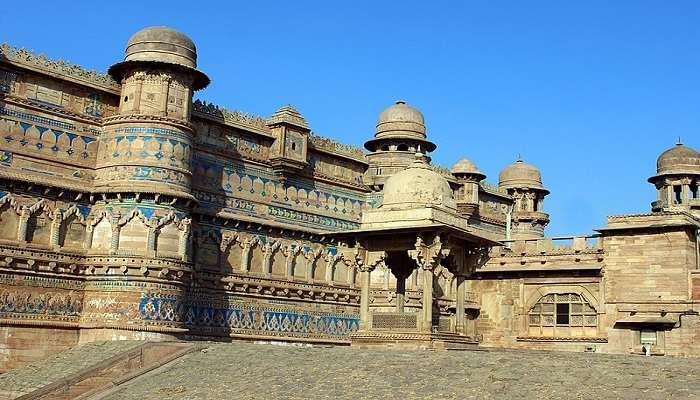
Known for being one of the strongest fortresses in India, it has stood through battles and the test of time. Several palaces, temples, and museums are situated within the fort, projecting the region’s rich history. The huge walls of the fort are high to facilitate a complete view of the city from its top. It is home to the famous Tansen’s tomb, which is dedicated to one of India’s earliest and best musicians. Carvings in a wide variety, huge courtyards and memorials are some other exhibits that make it an interesting place for history buffs.
Location: About 4 km from Jai Vilas Mahal
Timings: From 9 AM to 6 PM
Related Post: Atal Park Sagar
2. Teli Ka Mandir

Teli Ka Mandir is a tall temple inside the Gwalior Fort complex. It displays the Dravidian and North Indian styles in its architecture. Its new design and historical importance make this architectural wonder stand out. Worked on from top to bottom as a dedication to Lord Vishnu, it stands magnificently carved and richly adorned. The skilful craftsmanship of that time is reflected in the towering structure of the shikhara or spire, with its intricately sculpted forms illustrating different deities and mythological scenes. This architecture in Teli Ka Mandir makes it one of the most unique and interesting places that
A tourist can learn about cultural fusion prevalent in ancient India.
Location: About 5 km from Jai Vilas Mahal
Timings: From 9 AM to 6 PM
3. Sas-Bahu Temple

The Sas-Bahu Temple, located within the compound of Gwalior Fort, is literally a marvel of beautiful carvings and architectural grace. Actually, there are two temples in this temple complex that represent the creative enrichment of ancient Indian artisans. Carved pillars, beautiful sculptures and facades depicting scenes from Hindu religion are the hallmarks of the temples. Indeed, artistry skills that are reflected in the carvings, floral patterns and mythological narratives indicates a very high level of craftsmanship available during that period. These temples embody religious identity and depict architectural and cultural heritage in this region, which is of great interest for scholars, historians and tourists.
Location: About 5 km from Jai Vilas Mahal
Timings: From 9 AM to 6 PM
Related Post: Honeymoon Places In Madhya Pradesh
4. Gujari Mahal
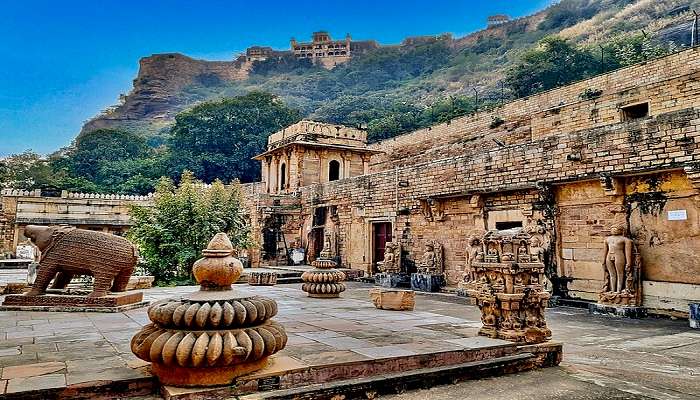
The Gujari Mahal is a palace situated within the premises of the Gwalior Fort, which dates back to the 15th century and has been converted into an archaeological museum. Raja Man Singh Tomar built this very palace for his beloved queen, Mrignayani, who belonged to the Gujjar community. Beautiful sculptures, pottery pieces, and ancient inscriptions form a part of this museum’s collection and help shed substantial light on the history and culture of the city. There are, among others, rare exhibits from the Gupta and Kushan periods, exquisite terracotta items, and intricately designed stone sculptures showing various deities and mythological scenes. A mammoth collection of weapons, coins, and manuscripts adorns this museum and explains the region’s historical evolution at length. These items have been so well-preserved that they shed significant light onto the life and times of ancient Gwalior, making Gujari Mahal a must-visit for history enthusiasts and scholars alike.
Location: About 4 km from Jai Vilas Mahal
Timings: From 9 AM to 6 PM
5. Sun Temple
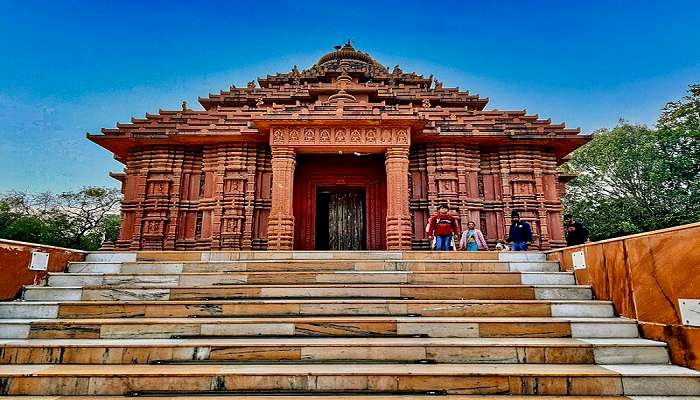
The Sun Temple in Gwalior is a new architectural marvel built in memory of the Sun God. This temple was built by the Birla family and is based on the lines of the famous Sun Temple located in Konark. It is decorated with carvings and sculptures. This temple is almost exactly similar to the one at Konark, with a chariot-shaped structure and exquisite artwork depicting scenes from Hindu mythology. The serene environment and architecture make this temple very famous among both devotees and tourists who come to pay a visit. These are surrounded by lush gardens, thereby increasing the tranquil environment of the temple and making it a peaceful retreat for visitors.
Location: About 8 km from Jai Vilas Mahal
Timings: From 7 AM to 7 PM
Related Post: Restaurants In Gwalior
How To Reach Jai Vilas Mahal

By Air: The nearest airport is Rajmata Vijaya Raje Scindia Airport in Gwalior. It enjoys great connectivity with major cities of India. From the airport, one can hire a taxi or bus to easily reach Jai Vilas Mahal.
By Train: Gwalior Junction is the nearest railway station and is linked with the main cities in India. One can hire a taxi or an auto-rickshaw from the railhead and reach the palace.
By Road: Gwalior is well linked by road with all the cities lying nearby towns and cities. There are bus services to this town of Madhya Pradesh from other major cities of Madhya Pradesh and also from the nearby states. One can also hire a taxi for a smooth journey.
Best Time To Visit Jai Vilas Mahal
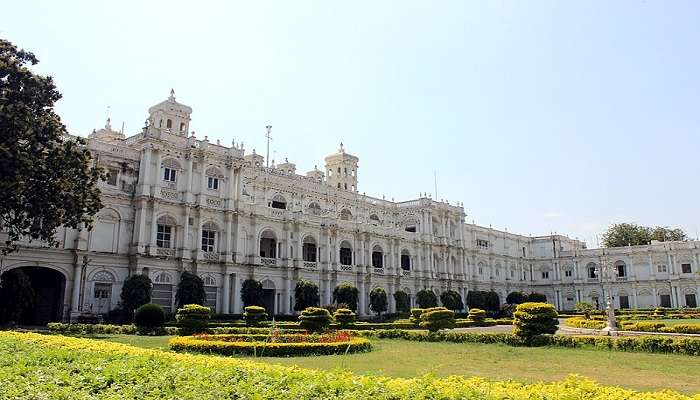
The best time to visit the Jai Vilas Mahal is, in my opinion, from October to March; during the winter, the best time is when people can comfortably look around the nearby areas without much hassle.
The temperatures are bearable, and it is comfortable to walk around and appreciate the marvels of architecture and art of the palace. Summers are avoided when planning a visit as temperatures rise significantly and outdoor activities can be quite uncomfortable.
You May Also Like To Read: Historical Places In Bhopal
Jai Vilas Mahal gives an insight into the opulence and rich heritage of the Scindias. From the magnificent Durbar Hall with its enormous chandeliers to the great number of royal artefacts in the Scindia Museum, every nook and corner of Jai Vilas Mahal pulsates with the splendour and memory of the Scindia rulers. One will step back in time by visiting this majestic palace to get memorable and enriching experiences that can never be forgotten for the rest of one’s life, especially by those who are fanatic about history and royal splendour. Plan a visit to Jai Vilas Mahal to get enchanted by its timeless beauty and majesty. It is definitely a royal marvel. Book your trip to Madhya Pradesh now!
For our editorial codes of conduct and copyright disclaimer, please click here.
Cover Image Credit : Mohitkjain123 for Wikimedia Commons
Frequently Asked Questions About Jai Vilas Mahal
What is Jai Vilas Mahal famous for?
Jai Vilas Mahal is famous for its architecture, the grand Durbar Hall with massive chandeliers, and a collection of royal artefacts housed in the Scindia Museum.
Is photography allowed in Jai Vilas Mahal premises?
Yes, but tourists must inquire at the time of visit in case there are any specific terms and conditions. Also if you are carrying a specific camera it's better to know before visiting with the gadget.
When is Jai Vilas Mahal open for visitors?
Visitors can, in general, visit Jai Vilas Mahal between 10 AM to 4:30 PM. If someone has to confirm, it is good to visit the official website or contact them about the visiting hours.
Do visitors have to pay an entry fee to be able to visit Jai Vilas Mahal?
The entrance fee varies for Indian and foreign tourists. The latest fee structure should be checked before visiting.
Are there any guided tours of Jai Vilas Mahal?
There are guided tours in Jai Vilas Mahal. A visitor can even hire a guide to gain a complete experience with all the details of the history, architecture, and other things related to this palace.
People Also Read:
Taj Mahal Hawa Mahal Jaipur Malcha Mahal

Unveil the hidden treasures of the globe and turn every travel dream into reality. As a Content Writer, I am passionate enough to craft stories from ancient wonders to modern marvels. My words paint the picture-perfect itinerary for unforgettable experiences. Let my words be your trusted guide to immerse in the diverse culture and discover the beauty of the unknown.











